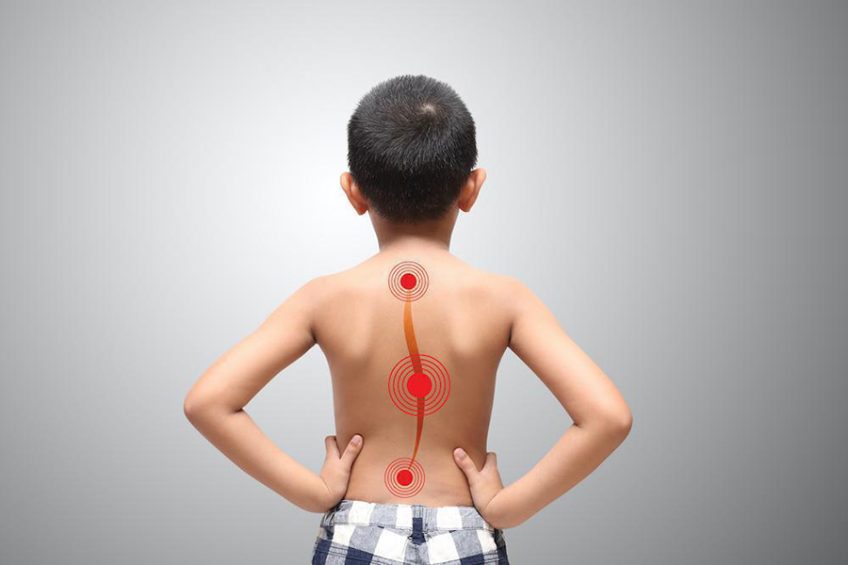Child Scoliosis is a three-dimensional deficiency that curves the spine, especially in the lumbar region, in the frontal plane, the column taking either the shape of the letter “C” or the shape of the letter “S”. Cases of scoliosis have increased in recent years, being an increasingly common condition among children.
In most cases, scoliosis does not limit movement and does not cause consistent back pain until it becomes severe, when it can lead to difficulty breathing, weakness, numbness or pain in the lower extremities.
There are two main types of scoliosis in children:
- structural, also involves a change in the structure of the elements of the spine – axis rotation of the thoracic vertebrae;
- functional, it is determined by the inadequate posture, by a sudden / exaggerated increase in height, but it can also appear as a result of a pain (muscle spasm), inflammatory process, limb inequality, etc. It does not involve changes in the structure of the spine.
Did you notice a strange posture in the little one? Do you think your shoulders are uneven? Does it have curves of the body to the left or to the right? Here are the possible causes and effects of scoliosis in children. Still in the fast-growing phase, preschoolers and first graders are prone to changing the shape of the spine with long-term repercussions.
Excluding rare diseases that occur at birth, such as congenital or neuromuscular scoliosis, idiopathic scoliosis is common in the population. Deviation of the spine, either in the thoracic or lumbar, occurs at an early age, from the first years of life until adolescence. They can occur, much less often, in the case of people over 16-20 years old.
Therefore, although the triggers of scoliosis are not fully recognized and scientifically proven, we can assume that certain conditions in the lifestyle of children close to school age are the key by which we can understand, recognize and remedy this condition.
CONTENT:
Causes of Child Scoliosis
Until we reach the serious cases, which require surgery or wearing a corrective corset, we need to understand that the dangerous deformation of the verticality of the spine starts, in fact, from a deficient posture. And what are the positions and circumstances that do not benefit the children’s column?
Well, those in which we can see, from the outside, that they involve an unnatural curvature and that extend unhealthily, for tens of minutes in a row.
A. Using the phone or tablet
If there is an abuse of access to technology, it means that the little one is static for a long time and prone to scoliosis. When we look at a screen, we usually do it with our heads down and our backs hunched over, and for children, this position is more dangerous than for adults, because the former are still growing.
B. Any sedentary lifestyle
When children do not spend time daily using their muscles and bones in motion, or playing a sport several times a week, the spine is not properly supported.
C. The student’s position in the bench
The school schedule involves many hours spent sitting, and if the child does not keep both feet on the floor and his back supported by the backrest or on both elbows, on the desk, it is possible that in time there will be a deviation of the column to the left or to the right. depending on the incorrect position he adopts for several consecutive hours. Observe how your child sits and teach him to correct his own posture.
Symptoms of Child Scoliosis
Some common aspects visible to the naked eye that may indicate the presence of scoliosis are:
- difference between shoulder height;
- the head is not centered with the rest of the body;
- difference in hip height or position (uneven hips);
- the spine has a twisted position;
- difference in the height or position of the shoulder blades (a shoulder blade is more prominent);
- the ribs are more prominent on one side of the body;
- when the child is standing, there is a difference between the way his arms hang next to his body (arms have different lengths);
- when leaning forward, the sides of the back appear different in height;
- there are problems with breathing due to the small area of the chest for the lungs to swell;
- back pain when scoliosis is in an aggravated form;
- last but not least, fatigue that occurs after long periods in a sitting or standing position, can be a symptom – the muscles in the back must work more intensely to maintain the balance of the body;
Scoliosis can be combated with the help of physical therapy, through exercises of balancing, toning and postural correction, to restore the correct position of the spine.


